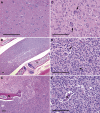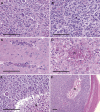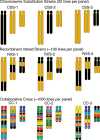Brain tumor susceptibility: the role of genetic factors and uses of mouse models to unravel risk
- PMID: 19076777
- PMCID: PMC2761018
- DOI: 10.1111/j.1750-3639.2008.00236.x
Brain tumor susceptibility: the role of genetic factors and uses of mouse models to unravel risk
Abstract
Brain tumors are relatively rare but deadly cancers, and present challenges in the determination of risk factors in the population. These tumors are inherently difficult to cure because of their protected location in the brain, with surgery, radiation and chemotherapy options carrying potentially lasting morbidity for patients and incomplete cure of the tumor. The development of methods to prevent or detect brain tumors at an early stage is extremely important to reduce damage to the brain from the tumor and the therapy. Developing effective prevention or early detection methods requires a deep understanding of the risk factors for brain tumors. This review explores the difficulties in assessing risk factors in rare diseases such as brain tumors, and discusses how mouse models of cancer can aid in a better understanding of genetic risk factors for brain tumors.
Figures





Similar articles
-
Capturing the molecular and biological diversity of high-grade astrocytoma in genetically engineered mouse models.Oncotarget. 2012 Jan;3(1):67-77. doi: 10.18632/oncotarget.425. Oncotarget. 2012. PMID: 22287481 Free PMC article. Review.
-
[Analysis of S100beta-v-erbB transgenic rats prone to brain tumors].Brain Nerve. 2009 Jul;61(7):765-72. Brain Nerve. 2009. PMID: 19618853 Review. Japanese.
-
Emerging role of new transgenic mouse models in glioma research.Expert Rev Anticancer Ther. 2007 Dec;7(12 Suppl):S7-13. doi: 10.1586/14737140.7.12s.S7. Expert Rev Anticancer Ther. 2007. PMID: 18076321 Review.
-
Neural and cancer stem cells in tumor suppressor mouse models of malignant astrocytoma.Cold Spring Harb Symp Quant Biol. 2008;73:421-6. doi: 10.1101/sqb.2008.73.005. Epub 2008 Nov 6. Cold Spring Harb Symp Quant Biol. 2008. PMID: 19022744 Review.
-
Genetically engineered mouse models of astrocytoma: GEMs in the rough?Semin Cancer Biol. 2001 Jun;11(3):177-91. doi: 10.1006/scbi.2000.0375. Semin Cancer Biol. 2001. PMID: 11407943 Review.
Cited by
-
Presenting Psychiatric and Neurological Symptoms and Signs of Brain Tumors before Diagnosis: A Systematic Review.Brain Sci. 2021 Feb 27;11(3):301. doi: 10.3390/brainsci11030301. Brain Sci. 2021. PMID: 33673559 Free PMC article. Review.
-
Gene therapy for brain cancer: combination therapies provide enhanced efficacy and safety.Curr Gene Ther. 2009 Oct;9(5):409-21. doi: 10.2174/156652309789753301. Curr Gene Ther. 2009. PMID: 19860655 Free PMC article. Review.
-
New Era of Immunotherapy in Pediatric Brain Tumors: Chimeric Antigen Receptor T-Cell Therapy.Int J Mol Sci. 2021 Feb 27;22(5):2404. doi: 10.3390/ijms22052404. Int J Mol Sci. 2021. PMID: 33673696 Free PMC article. Review.
-
Antioxidants in brain tumors: current therapeutic significance and future prospects.Mol Cancer. 2022 Oct 28;21(1):204. doi: 10.1186/s12943-022-01668-9. Mol Cancer. 2022. PMID: 36307808 Free PMC article. Review.
-
Correlation of Molecular Status with Preoperative Olfactory Function in Olfactory Groove Meningioma.Cancers (Basel). 2024 Apr 22;16(8):1595. doi: 10.3390/cancers16081595. Cancers (Basel). 2024. PMID: 38672677 Free PMC article.
References
-
- Ahlbom A, Feychting M, Cardis E, Elliott P (2007) Re: cellular telephone use and cancer risk: update of a nationwide Danish cohort study. J Natl Cancer Inst 99:655; author reply ‐6. - PubMed
-
- Astrinidis A, Henske EP (2005) Tuberous sclerosis complex: linking growth and energy signaling pathways with human disease. Oncogene 24:7475–7481. - PubMed
-
- Ballester R, Marchuk D, Boguski M, Saulino A, Letcher R, Wigler M, Collins F (1990) The NF1 locus encodes a protein functionally related to mammalian GAP and yeast IRA proteins. Cell 63:851–859. - PubMed
-
- Bell DW, Varley JM, Szydlo TE, Kang DH, Wahrer DC, Shannon KE et al (1999) Heterozygous germ line hCHK2 mutations in Li‐Fraumeni syndrome. Science 286:2528–2531. - PubMed
-
- Bethke L, Sullivan K, Webb E, Murray A, Schoemaker M, Auvinen A et al (2008) The common D302H variant of CASP8 is associated with risk of glioma. Cancer Epidemiol Biomarkers Prev 17:987–989. - PubMed
MeSH terms
Grants and funding
LinkOut - more resources
Full Text Sources
Medical

